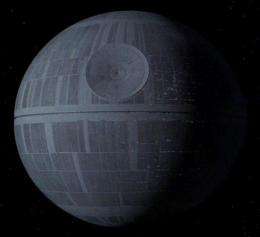Could a 'Death Star' really destroy a planet?

Countless Sci-Fi fans vividly remember the famous scene in Star Wars in which the Death Star obliterates the planet Alderaan.
Mirroring many late night caffeine-fueled arguments among Sci-Fi fans, a University of Leicester researcher asks the question:
Could a small moon-sized battle station generate enough energy to destroy an Earth-sized planet?
A paper by David Boulderston (University of Leicester) sets out to answer that very question. First, for the uninitiated, just what the heck is a Death Star?
According to Star Wars lore, the DS-1 Orbital Battle Station, or Death Star, is a moon-sized battle station designed to spread fear throughout the galaxy. The image above shows the Death Star as it appeared in Star Wars Episode IV: A New Hope (1977). The Death Star’s main weapon is depicted as a superlaser capable of destroying planets with a single blast.
Boulderston claims that it is possible to estimate how much energy the Death Star would need in order to destroy a planet with its superlaser. There are a number of assumptions made, however, in order to come up with the energy requirement.
For starters, Boulderston assumed that Alderaan did not have any sort of planetary “deflector” shield. A second assumption is that the planet is a solid body of uniform density – essentially ignoring the complex interior of planets, due to lack of information on Alderaan itself. Using the idealized sphere model based on Earth’s mass and diameter, it was possible to determine the gravitational binding energy of Alderaan, using a simple equation of:
U= 3GMp2
——
5Rp
Where G is the Gravitational Constant (6.673×10-11), Mp is planet mass, and Rp is the planet’s radius. Using Earth’s mass and radius, the required energy comes out to 2.25 x 1032 Joules. Using Jupiter’s data, the energy required goes up to 2 x 1036 Joules.
Boulderston asserts that (according to Star Wars lore) the Death Star is powered by a ‘hypermatter’ reactor, possessing the energy output of several main-sequence stars. Given that the power output of our Sun is about 3 x 1026 Joules per second, it’s a reasonable assumption the Death Star’s reactor could power the superlaser.
Despite using a simplified model of a planet, Boulderstone states the simplified model is reasonable to use since the Death Star’s main power reactor has the energy output equal to several main-sequence stars. Even if Earth’s exact composition were used in the equation above, the required energy to destroy a planet would only be affected by a few orders of magnitude – well within the Death Star’s power budget.
Boulderstone reiterated that the energy required to destroy a Jupiter-sized planet would put considerable strain on the Death Star. To destroy a planet like Jupiter, all power from essential systems and life support (no re-routing from the auxiliary EPS conduits – that’s a Star Trek hack!) would be required, which is not necessarily possible.
Boulderstone’s conclusion is that the Death Star could indeed destroy Earth-like planets, given its main power source. While the Death Star could destroy an Earth-sized planet, a Jupiter-sized planet would be a tough challenge, and the Galactic Empire would need to resort to using a Suncrusher to destroy stars.
If you’d like to read Boulderstone’s paper, you can access it at: physics.le.ac.uk/journals/inde … article/view/328/195
Source: Universe Today



















